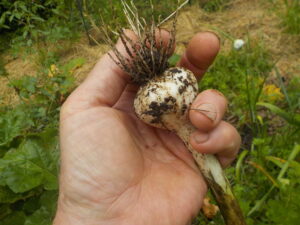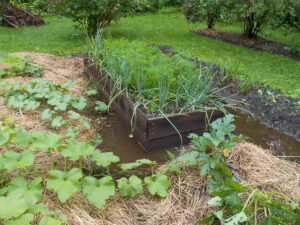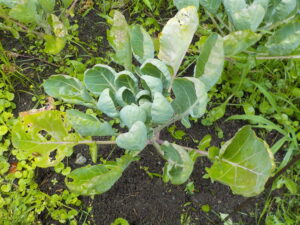Pick Today? Pick Tomorrow? Pick Next Week?
We have seen more rain than usual – much more. Even a quick shower results in standing water in the walkways between my mounded raised beds. But in addition to the excess water, plants aren’t getting their usual allotment of sunshine. They need sun – strong, bright sun – to grow and produce fruits and leaves. The lack of sunshine is what is causing smaller veggies, yellowed leaves, and later ripening.

This garlic is smaller than I would expect, but the skin is strong and the others can continue to grow
Here’s what I do: I start by groping my garlic: I slip my hand into the soil and feel how big the bulbs are. I don’t pull them if they’re tiny. But to be on the safe side, I pull a few and look at the skin over the cloves. I want the skins to be strong and tight for good storage. If they are breaking down (due to all the rain), I pull my garlic. If not, I let them keep growing, but check them often.
My Brussels sprouts plants are also much smaller than normal this year. Fortunately, they will continue to grow until the end of October, or even later. If we get sunshine soon, they should recover. My normal advice is to cut the tops of the plants off on Labor Day weekend so that the plants don’t keep growing taller but instead send their energy into producing big “sprouts”. This year I’ll be lucky if they have stalks at all. So I will wait and see – and I accept that my harvest might be small or non-existent.
A Time to Harvest
Sometimes it’s tough to know just when to pick things in the vegetable garden. We don’t want to pick produce before it’s ready, but neither do we want to pick them after our fruits have passed their prime. And to confuse matters even more, each variety of vegetable has its own moment of perfection.
I remember the first time I grew ‘Green Zebra’ tomatoes and waited for them to get ripe. They didn’t appear to. Then a few fell off the vine – they were overripe. The only way I could tell they were ripe was by the feel. When they started to get soft, they were ripe. But mostly I pick tomatoes by their color.
Green beans are best before they show the lumps that are the individual seeds. Young beans are delicious, but of course, you don’t want to pick them when they are too young, as you’ll get less production that way. Some beans, especially pole beans like ‘Kwintus’ (from Cook’s Garden Seeds) are still very tasty when you can see individual beans in the pods. Part of knowing when to pick is letting a few things get older than they should, and then remembering what they look like.
By now your onions have been harvested, I suppose. They are easy to identify as ready to harvest: the tops fall over and turn brown. If yours are still in the ground, go get them! Although you can pull the onions and let them dry/cure in the garden, I think it is better to dry them on a porch or deck out of the rain.
Beets taste the same, or almost, whether picked early or late. I eat the thinnings early in the season, I eat some mid-season, I harvest some after frost. Frost does not harm them – if anything, it even makes them a little sweeter. Carrots are much the same. I don’t find that my big, late carrots get woody – but if the variety that you grow does get woody, pick them earlier.
Potatoes keep on getting bigger until the leaves brown up and flop over. I generally pull potatoes before then, but last year my granddaughter, Casey, grew potatoes and did not get to harvest them until the tops had pretty much disappeared. The potatoes were still perfect – though as a general rule I wouldn’t let potatoes stay in the ground that late, fearing that they might rot in a rainy spell. Frost does not harm them.
Sweet peppers will turn red, but if you let them stay on the vine to get red, you lose production. If you pick them green, the plants keep on flowering and producing more peppers. Hot peppers get hotter if you let them stay on the vine until they are fully ripe.
Lettuce can be harvested either as a cut-and-come-again crop, or harvested as heads. If lettuce plants start getting tall, they’re getting ready to bolt and flower. So I try to pick them before they do so – a bolting lettuce gets bitter.
When broccoli heads start to show yellow, they are about to go by. The flowers are yellow, and you want to pick the heads or side shoots before the flowers appear as flowers. But if they do flower, they’re still edible. And cut anything off that has flowered, so it will stimulate the plant to make more side shoots.
Kale can be harvested any time; I like to keep it growing well into the fall. Frost is not a problem, nor is snow. I keep picking kale until the temperatures go down into the teens. The oldest leaves, down at the bottom of the plant, can get a little tough with time. Be sure to remove the central rib before you cook or freeze the leaves.
Summer squash can be picked very small – or quite large. Patty pan squash, one of my favorites, is perfect at the 4-inch diameter size, though I know someone who picks it at the 2-inch size – almost bite sized. Zucchini grows so fast that I often find some – the escapees- that are 18 inches long. Those I quarter lengthwise and scoop out the seeds. Then I run them through the shredder (top) blade of my food processor, making a nice mixture that I freeze as is. I use it as a base for making winter soups.
Speaking of winter, winter squash are a bit tricky to pick at just the right moment. What I have decided is that it really doesn’t matter when you pick them. When my blue hubbards or Waltham butternuts stop growing, or when I see that the stem is drying up, I pick them. Winter squash need to be cured for some weeks before eating for the best flavor.
Apples? If you have to yank on an apple to get it off the tree, it’s not ready to pick. If lots of apples are on the ground, the tree is probably ready to pick. Pears are usually picked green, and ripened on a window sill or in trays in the barn. Plums, like apples, come off in my hand at a gentle touch when they are fully ripe, but I can also tell by the color.
Like much in life, practice – and paying attention – makes perfect when it comes to harvesting. That, and having enough time to go out and get in the garden when you need to. Happy harvesting!






